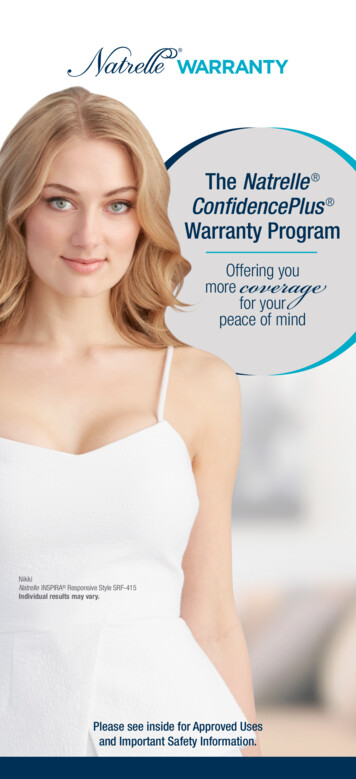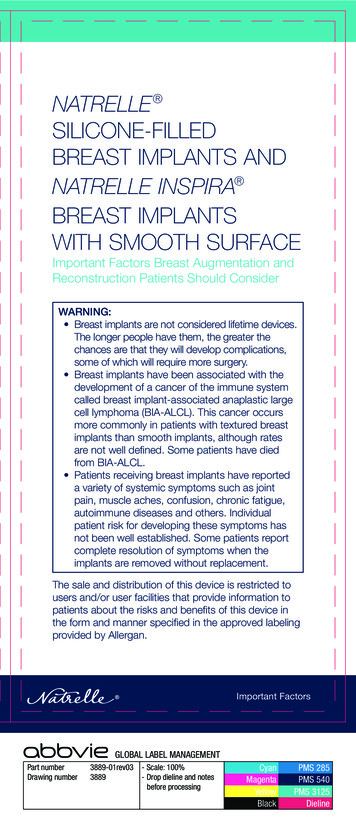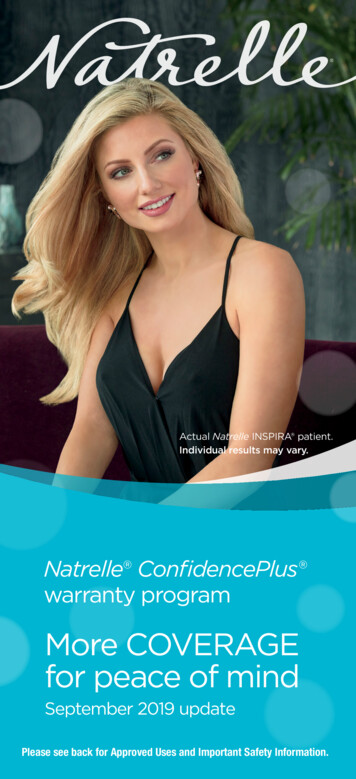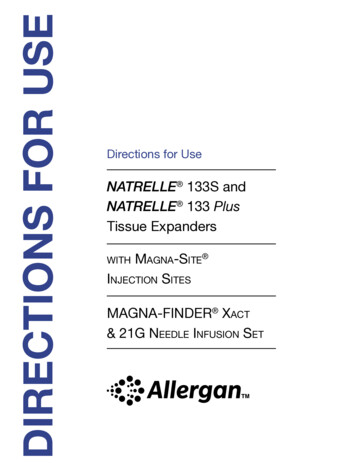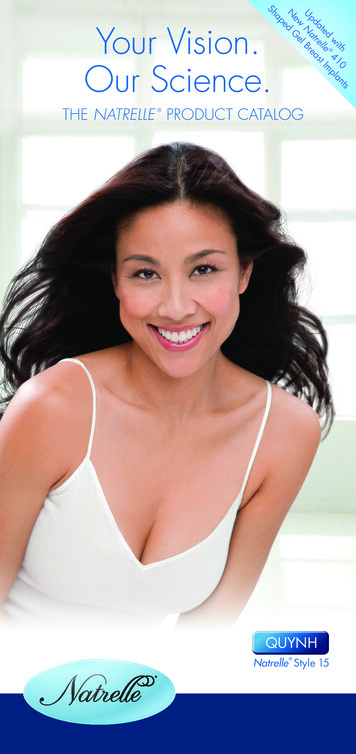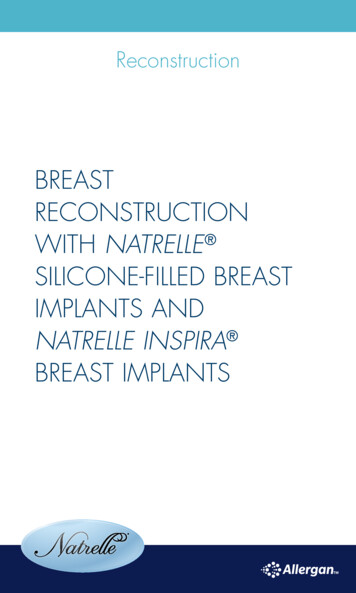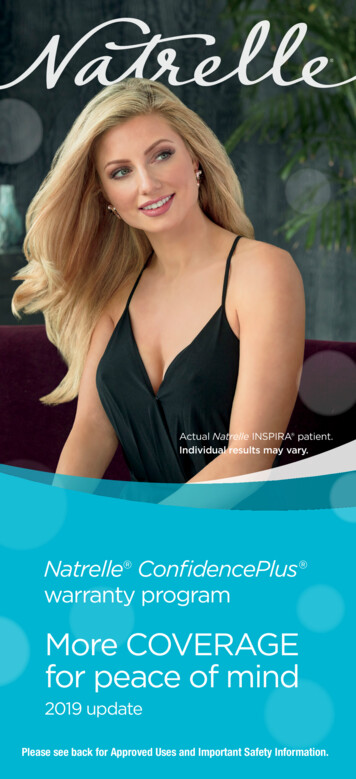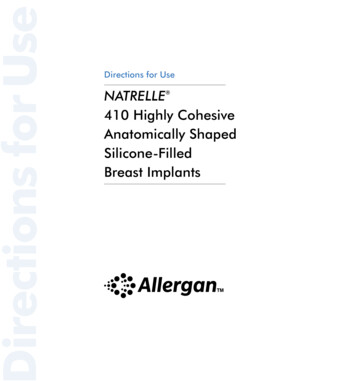
Transcription
irections for UseDirections for UseNATRELLE 410 Highly CohesiveAnatomically ShapedSilicone-FilledBreast Implants
Caution: Federal (USA) law restricts this device to sale by or on the order of a licensed physician.
TABLE OF CONTENTSIntroduction.Introduction1Directions to the Physician .1Patient Counseling and Informed Decision Information.1InformationDevice Tracking.Tracking .2Device Description.Description2Indications . 5Contraindications . 5Warnings.Warnings6PrecautionsPrecautions. 7Specific PopulationsPopulations.7Additional PrecautionsPrecautions.8Patient Counseling Information: Important Factors, Possible Adverse Events and OtherReported ConditionsConditions. 8General Patient Counseling Information .8Important Factors to Convey to PatientsPatients.9Events. 12Possible Adverse EventsOther Reported ConditionsConditions. 19Studies. 26Allergan’s Clinical StudiesMM).26410 Pivotal Study Overview (Styles FF, FM, MF, MM)FL).47410XL-001 Study Overview (Styles FX, MX, LX, LF, LM, LL, ML, FL)Characteristics.47Patient Demographics and Baseline Surgical CharacteristicsStudies. 55Allergan’s Post-Approval StudiesInstructions for UseUse. 55Preoperative Education, Planning and Preparation .55Intraoperative Device Examination and Handling .57Device Implantation and Explantation ConsiderationsConsiderations.58Page i
Documentation the Physician Should Provide to the Patient.Patient61Additional Specific Product InformationInformation. 61BIOCELL Textured Breast Implant Delivery Assistance SleeveSleeve.61Returned Goods Policy.Policy .61Reporting and Return of Explanted DevicesDevices.61 ConfidencePlus Limited Warranty.61WarrantyProduct OrderingOrdering.62Reporting ProblemsProblems.62ReferencesReferences. 63Page ii
INTRODUCTIONDirections to the PhysicianThe information supplied in this Directions for Use document is intended to provide physicians anoverview of essential information about NATRELLE 410 Highly Cohesive Anatomically ShapedSilicone-Filled Breast Implants, including the indications for use, contraindications, warnings,precautions, important factors for a patient to consider, adverse events, other reported conditions,instructions for use and a summary of Allergan’s pivotal clinical study results.Patient Counseling and Informed Decision InformationYou should review this document prior to counseling the patient about breast implant surgery withNATRELLE 410 Highly Cohesive Anatomically Shaped Silicone-Filled Breast Implants. Pleasefamiliarize yourself with the content of this document and resolve any questions or concerns priorto proceeding with use of the device. As with any surgical procedure, breast implantation is NOTwithout risks. Breast implantation is an elective procedure, and the patient must be well counseledand understand the risk/benefit relationship.Each patient should receive Allergan’s patient brochure, NATRELLE 410 Highly CohesiveAnatomically Shaped Silicone-Filled Breast Implants: Important Factors BreastAugmentation and Reconstruction Patients Should Consider and be informed that Allergan’spatient labeling, Breast Augmentation/Reconstruction with NATRELLE 410 HighlyCohesive Anatomically Shaped Silicone-Filled Breast Implants is also available online(www.allergan.com/labeling/usa.htm), during her initial visit/consultation. She should be advisedof the potential complications and that medical management of serious complications mayinclude additional surgery and explantation. The patient should be advised to wait at least 12 weeks after reviewing and considering this information before deciding whether to have thissurgery, unless an earlier surgery is deemed medically necessary.In order to document a successful informed decision process, the Acknowledgement ofInformed Decision document (available separately and within the patient labeling document at:www.allergan.com/labeling/usa.htm) should be signed by both the patient and the surgeon andthen retained in the patient’s file.For detailed instructions regarding patient counseling and informed consent, please see thesection “Patient Counseling Information: Important Factors, Possible Adverse Events and OtherReported Conditions” on page 8.Page 1
CertificationCertification via Allergan’s Physician Certification Program specific to NATRELLE HighlyCohesive Silicone-Filled Breast Implants is required in order to gain access to these implants.Please see the section “Preoperative Education, Planning and Preparation” in the Instructionsfor Use, visit www.allerganacademy.com, or contact your local Breast Aesthetics BusinessDevelopment Manager or the Allergan Customer Care Department for detailed traininginformation.Device TrackingNATRELLE 410 Highly Cohesive Anatomically Shaped Silicone-Filled Breast Implants are subjectto Device Tracking per federal regulation. This means that the physician is required to report toAllergan the serial number of the implanted device(s), the date of surgery, information relating tothe physician’s practice, and information on the patient receiving the implant(s). This informationshould be recorded on the Device Tracking Form supplied by Allergan with each siliconegel-filled breast implant. Following surgery, return the first page of the form to Allergan by fax,using the contact information provided on the form.The second page of the form should be provided to the patient following surgery. The patient hasthe right to have her personal information removed from Allergan’s Device Tracking program.However, Allergan strongly recommends that all patients receiving NATRELLE 410 HighlyCohesive Anatomically Shaped Silicone-Filled Breast Implants participate in Allergan’s DeviceTracking program. This will help ensure that Allergan has a record of each patient’s contactinformation. Patients should be encouraged to complete the Device Tracking Form and return it toAllergan so that they can be contacted in the event of a recall or other problems with the implants.DEVICE DESCRIPTIONNATRELLE 410 Highly Cohesive Anatomically Shaped Silicone-Filled Breast Implants areconstructed with barrier shell technology and are filled with Highly Cohesive silicone gel. Allstyles are single “lumen” anatomically shaped and consist of a shell, patch, and silicone gel fill.Allergan has approval for 3 types of silicone gel fillers: Responsive silicone gel, SoftTouch siliconegel, and Highly Cohesive silicone gel. Allergan’s Responsive silicone gel is a softer gel thanAllergan’s SoftTouch silicone gel, which is softer than Allergan’s Highly Cohesive silicone gel. ThePage 2
use of Highly Cohesive silicone gel in NATRELLE 410 Breast Implants is intended to allow theimplant to maintain its shape in any position (form stable). NATRELLE 410 Breast Implants havethe BIOCELL surface texture.NATRELLE 410 Highly Cohesive Anatomically ShapedSilicone-Filled Breast ImplantORIENTATION MARKSBIOCELL TEXTURED SHELLRSILICONE GEL FILLPATCH, INNER BARRIERORIENTATION MARKSORIENTATION MARKSPATCH, OUTER LAYERDIP COATNATRELLE 410 Breast Implants incorporate orientation marks on the anterior and posterior sidesof the shell surface to assist in aligning the implant vertically in the pocket. Two orientation marksare present on the anterior side of the implant in the lower pole. Depending on the style, there willbe either 3 or 4 orientation marks on the posterior surface of the implant.General Orientation Mark LocationsandorPosterior View,4 MarksPosterior View,3 MarksPage 3Anterior View,2 Marks
To allow for selection of the appropriate implant to fit the specific needs of the patient, NATRELLE 410 Highly Cohesive Anatomically Shaped Silicone-Filled Breast Implants are offered in a rangeof implant heights and projections.Table 1: Styles of NATRELLE 410 Breast Implants410 StyleBreast jection(cm)FLFull height,Low projection140 - 32010.5 - 13.510.0 - 13.02.9 - 3.8MLModerate height,Low projection125 - 2859.1 - 12.110.0 - 13.02.9 - 3.8LLLow height,Low projection135 – 3008.6 – 11.410.5 – 13.53.0 – 4.0FMFull height,Moderate projection205 – 67011.0 – 16.010.5 – 15.53.8 – 5.6MMModerate height,Moderate projection160 – 4509.1 – 12.910.0 – 14.03.6 – 5.2LMLow height,Moderate projection140 – 3208.1 – 10.910.0 – 13.03.6 – 4.8FFFull height,Full projection185 – 74010.5 – 16.010.0 – 15.54.0 – 6.2MFModerate height,Full projection140 – 6408.6 – 13.99.5 – 15.53.7 – 6.2LFLow height,Full projection125 – 5957.6 – 13.09.5 – 15.53.7 – 6.2FXFull height,Extra full projection185 - 77510.0 – 16.09.5 – 15.54.6 – 7.1MXModerate height,Extra full projection165 - 6858.6 – 13.99.5 – 15.54.6 – 7.1LXLow height,Extra full projection145 – 6257.6 – 13.09.5 – 15.54.6 – 7.1Page 4
INDICATIONSNATRELLE 410 Highly Cohesive Anatomically Shaped Silicone-Filled Breast Implants areindicated for women for the following: Breast augmentation for women at least 22 years old. Breast augmentation includesprimary breast augmentation to increase the breast size, as well as revision surgery to correct orimprove the result of a primary breast augmentation surgery. Breast reconstruction. Breast reconstruction includes primary reconstruction to replace breasttissue that has been removed due to cancer or trauma or that has failed to develop properly dueto a severe breast abnormality. Breast reconstruction also includes revision surgery to correct orimprove the result of a primary breast reconstruction surgery.CONTRAINDICATIONSBreast implant surgery should not be performed in: Women with active infection anywhere in their body Women with existing cancer or pre-cancer of their breast who have not received adequatetreatment for those conditions Women who are currently pregnant or nursingPage 5
WARNINGSAVOID DAMAGE DURING SURGERY Care should be taken to avoid the use of excessive force and to minimize handling of the implantduring surgical insertion. The unique nature of the highly cohesive gel creates an implant with aprecisely defined shape. Excessive force upon insertion of the implant may compromise this shape,potentially leading to an undesirable cosmetic outcome. Data accumulated from Allergan’s retrieval study analyses of explanted ruptured silicone gel-filledbreast implants, observations of surgeries, and a review of the published literature indicate thatforcing implants through too small an opening or applying concentrated localized pressure on theimplants may result in localized weakening of the breast implant shell potentially leading to shelldamage and possible implant rupture. An incision should be of appropriate length to accommodate the style, size, and profile of theimplant. Typically the incision needed for silicone-filled breast implants will be longer than the onemade for a saline breast augmentation. The unique nature of the more cohesive gel in the highlycohesive breast implant requires an even larger incision to reduce excessive stress on the implantduring insertion and minimize the potential for gel fracture (fissure in the gel) or deformation(change in shape). Care should be taken when using surgical instruments in proximity with the breast implant,including scalpel, sutures, and dissection instrumentation. Silicone gel-filled breast implants are prone to unintended instrument trauma during implantationor during explantation.1,2 Shell failure can result from damage by scalpels, suture needles,hypodermic needles, hemostats, and Adson forceps and has been observed in explanted deviceshells using scanning electron microscopy.1 Allergan’s (retrieval study) analyses of explanteddevices have identified unintended surgical instrument damage as one potential cause of shellfailure and thus implant rupture. Do not treat capsular contracture by closed capsulotomy or forceful external compression, whichwill likely result in implant damage, rupture, folds, and/or hematoma. Use care in subsequent procedures such as open capsulotomy, breast pocket revision, hematoma/seroma aspiration, and biopsy/lumpectomy to avoid damage to the implant.Page 6
Re-positioning of the implant during subsequent procedures should be carefully evaluated by themedical team and care taken to avoid contamination of the implant. Use of excessive force duringany subsequent procedure can contribute to localized weakening of the breast implant shellpotentially leading to decreased device performance. Do not contact the implant with disposable, capacitor-type cautery devices. Do not alter the implants or attempt to repair or insert a damaged prosthesis. Do not re-use or resterilize any product that has been previously implanted. Breast implants areintended for single use only. Do not place more than one implant per breast pocket. Do not use the periumbilical approach to place the implant. Do not use microwave diathermy in patients with breast implants. Microwave diathermy has beenreported to cause tissue necrosis, skin erosion, and implant extrusion.PRECAUTIONSSpecific PopulationsSafety and effectiveness have not been established in patients with the following: Autoimmune diseases (e.g., lupus and scleroderma) A compromised immune system (for example, currently receiving immunosuppressive therapy) Planned chemotherapy following breast implant placement Planned radiation therapy to the breast following breast implant placement Conditions or medications that interfere with wound healing and blood clotting. Reduced blood supply to breast tissue Clinical diagnosis of depression or other mental health disorders, including body dysmorphicdisorder and eating disorders. Please discuss any history of mental health disorders prior tosurgery. Patients with a diagnosis of depression, or other mental health disorders, should waituntil resolution or stabilization of these conditions prior to undergoing breast implantationsurgery.Page 7
Additional Precautions Preoperative Planning - Proper surgical planning such as allowance for adequate tissuecoverage, implant placement (i.e., submuscular vs. subglandular), incision site, implant type, etc.,should be made preoperatively. For detailed instructions on proper preoperative planning, pleaserefer to section “Preoperative Education, Planning and Preparation” on page 55. Back-up Implants - It is advisable to have more than one size breast implant in the operatingroom at the time of surgery to allow for flexibility in determining the appropriate size implant to beused. A back-up implant should also be available. Surgical Mesh - The use of surgical mesh or acellular dermal matrix together with the breastimplant has not been studied in the pivotal study. Explantation - If it is necessary to perform explantation of the implant, care must be taken tominimize manipulation of the product (particularly in regards to sharp-edged openings). Explanteddevices should be returned to Allergan for evaluation. Contact Allergan’s Product SurveillanceDepartment at 1.800.624.4261 for an Explant Kit and explant return instructions. Massage - Breast massage exercises following implantation with NATRELLE 410 Breast Implantsare not recommended as this may lead to implant malposition.PATIENT COUNSELING INFORMATION: IMPORTANTFACTORS, POSSIBLE ADVERSE EVENTS AND OTHERREPORTED CONDITIONSGeneral Patient Counseling InformationAs with any surgical procedure, breast implantation is NOT without risks. Breast implantation isan elective procedure, and the patient must be well counseled and understand the risk/benefitrelationship.Prior to making the decision to proceed with surgery, instruct the patient to read the patient labeling,Breast Augmentation/Reconstruction with NATRELLE 410 Highly Cohesive AnatomicallyShaped Silicone-Filled Breast Implants (available at: www.allergan.com/labeling/usa.htm).Page 8
1. The patient labeling (available at: www.allergan.com/labeling/usa.htm) is intended as theprimary means to relate uniform risk and benefit information to assist your patient in makingan informed decision about primary breast augmentation and revision-augmentation, orprimary reconstruction and revision-reconstruction surgery (as applicable), but it is notintended to replace consultation with you.2. Each patient should receive Allergan’s patient brochure and be informed that the patientlabeling is also available at: www.allergan.com/labeling/usa.htm during her initial visit/consultation to allow her sufficient time prior to surgery to read and adequately understandthe important information on the risks, follow-up recommendations, and benefits associatedwith highly cohesive silicone-filled breast implant surgery.3. It is important that all patients seeking to undergo elective surgery have realistic expectationsthat focus on improvement rather than perfection.4. Request that your patient openly discuss with you, prior to surgery, any history that she mayhave of depression or other mental health disorders.5. Allow the patient at least 1-2 weeks after reviewing and considering this information beforedeciding whether to have this surgery, unless an earlier surgery is deemed medically necessary.6. Discuss with the patient the warnings, precautions, important factors to consider, possibleadverse events, and Allergan’s pivotal clinical study results.7. Advise the patient of the possible adverse events and other reported conditions. Explainthat medical management of serious adverse events may include additional surgery andexplantation.In order to document a successful informed decision process, the Acknowledgementof Informed Decision document (available in the patient labeling document at:www.allergan.com/labeling/usa.htm) should be signed by both the patient and the surgeon andthen retained in the patient’s file.Important Factors to Convey to PatientsBelow are some of the important factors (Table 2), possible adverse events (Table 3), and otherconditions (Table 4) your patients need to be aware of when considering NATRELLE 410 BreastImplants. The patient labeling provides additional information on important factors for patients.Page 9
Table 2: Important Factors to Convey to PatientsInsurance coverage Patients should check with their insurance company regarding coverage issues beforeundergoing surgery Insurance coverage may differ based on whether breast implants are being used forbreast reconstruction or breast augmentation Patients should be advised that health insurance premiums may increase, insurancecoverage may be dropped, and/or future coverage may be denied based on thepresence of breast implants Diagnostic procedures will add to the cost of having breast implants, and patients shouldbe told that these costs may exceed the cost of their initial surgery over their lifetimes andthat these costs may not be covered by their insurance carrier Treatment of complications may not be coveredSmoking Smoking may interfere with the healing processRadiation to the Breast Allergan has not tested the effects of radiation therapy in patients who have breastimplants. The literature suggests that radiation therapy may increase the likelihood ofcapsular contracture, necrosis, and implant extrusionBreast Examination Techniques Patients should perform breast self-examinations monthly and be shown how todistinguish the implant from their breast tissue The patient should not manipulate or squeeze the implant excessively The patient should be told that the presence of lumps, persistent pain, swelling,hardening, or change in the implant shape may be signs of symptomatic rupture of theimplant. If the patient has any of these signs, she should be told to report them andpossibly have an MRI evaluation to screen for rupturePage 10
Mammography Presurgical mammography with a follow-up mammogram after implantation may beperformed to establish a baseline for routine future mammography in augmentationpatients Patients should be instructed to undergo routine mammography exams as per theirprimary care physician’s recommendations. The importance of having these exams shouldbe emphasized. The current recommendations for preoperative/screening mammogramsare no different for women with breast implants than for those women without implants Patients should be instructed to inform their mammographers about the presence, type,and placement of their implants Patients should have a diagnostic mammogram, rather than a screening mammogram,because more pictures are taken with a diagnostic mammogram Breast implants may complicate the interpretation of mammographic images byobscuring underlying breast tissue and/or by compressing overlying tissue Accredited mammography centers, technicians with experience in imaging patients withbreast implants, and use of displacement techniques are needed to adequately visualizebreast tissue in the implanted breast Prior to mammography the radiologist should be alerted to the presence and locationof the orientation marks on the NATRELLE 410 Highly Cohesive Anatomically ShapedSilicone-Filled Breast Implant as these may be visible on the mammographic images.These orientation marks are circular silicone elastomer dots located on the surface ofthe implant and are used to assist the physician with visual and tactile placement of theimplant within the surgical pocket.Page 11
MRI Screening for Breast Implant Rupture Breast implant rupture is considered “silent” when it occurs without any other problems,signs, or symptoms. Breast implant rupture is considered “symptomatic” when it isaccompanied by changes in the look or feel of the breast and/or breast implant. Adviseyour patient that she will need to have regular MRIs to screen for rupture even if she ishaving no problems. MRI screenings should be performed at 3 years postoperatively, then every 2 yearsthereafter. If your patient has symptoms of breast implant rupture (described in Table 4), you shouldrecommend that she has an MRI to determine whether rupture is present.3,4 Provide yourpatient with a list of MRI facilities in her area that have: at least a 1.5 Tesla magnet, a dedicated breast coil, and a radiologist experienced with breast implant MRI films for signs of rupture If rupture is noted via MRI, then you should advise your patient to have her implantremovedAvoiding Damage During Treatment Patients should inform other treating physicians of the presence of implants to minimizethe risk of damage to the implantsPOSSIBLE ADVERSE EVENTSPotential adverse events that may occur with silicone gel-filled breast implant surgery include:implant rupture, capsular contracture, reoperation, implant removal, pain, changes in nippleand breast sensation, infection, scarring, asymmetry, wrinkling, implant displacement/migration,implant palpability/visibility, breastfeeding complications, hematoma/seroma, implant extrusion,necrosis, delayed wound healing, breast tissue atrophy/chest wall deformity, calcium deposits, andlymphadenopathy.Table 3 contains a description of these adverse events. For specific adverse event rates/outcomesfor NATRELLE 410 Highly Cohesive Anatomically Shaped Silicone-Filled Breast Implants, refer tothe pivotal study section below on page 26.Page 12
Table 3: Possible Adverse EventsRupture Breast implants are not lifetime devices. Breast implants rupture when the shell develops a tear or hole. Ruptures can occur atany time after implantation, but they are more likely to occur the longer the implant isimplanted. The following things may cause implants to rupture: damage by surgical instruments,stressing the implant during implantation and weakening it, folding or wrinkling of theimplant shell, excessive force to the chest (e.g., during closed capsulotomy, which iscontraindicated), trauma, compression during mammographic imaging, and severecapsular contracture. Breast implants may also simply wear out over time. Laboratorystudies have identified some of the causes of rupture for Allergan’s product. It is notconclusively known whether these tests have identified all causes of rupture. Laboratorystudies to identify any additional causes of rupture are ongoing. Silicone gel-filled implant ruptures are most often silent. This means that most of thetime neither you nor your patient will know if the implant has a tear or hole in the shell.MRI examination is currently the best method to screen for rupture. See Table 2 foradditional information regarding MRI screening. Sometimes there are symptoms associated with gel implant rupture. These symptomsinclude hard knots or lumps surrounding the implant or in the armpit, change or loss ofsize or shape of the breast or implant, pain, tingling, swelling, numbness, burning, andhardening of the breast. When MRI signs of rupture are found (such as subcapsular lines, characteristic foldedwavy lines, teardrop sign, keyhole sign, noose sign), or if there are signs or symptomsof rupture, you should remove the implant and any gel you determine your patient has,with or without replacement of the implant. It also may be necessary to remove thetissue capsule. There are also consequences of rupture. If rupture occurs, silicone gel may eitherremain within the scar tissue capsule surrounding the implant (intracapsular rupture),move outside the capsule (extracapsular rupture), or move outside the breast (gelmigration). There is also a possibility that rupture may progress from intracapsular toextracapsular and beyond.Page 13
Rupture information from the Allergan 410 Pivotal StudyIn Allergan’s pivotal study, there was a MRI screening cohort who had regular MRIsto screen for breast implant rupture whether or not they were symptomatic (i.e., MRIcohort), and a non-MRI screening cohort who were not screened with breast implantMRIs (i.e., non-MRI cohort). On May 27, 2008, FDA approved a protocol revisionso that all enrolled patients – both MRI and non-MRI cohorts – would receive MRIevaluations at the 7 and 9 year follow-up timepoints.Across all patients in the pivotal study, all of the ruptures were intracapsular, with nocases of extracapsular rupture or migrated gel.The rupture rate for the MRI cohort through 10 years was 16.4% for patients and9.7% for implants. The cumulative rupture rates for the MRI and non-MRI cohorts byindication are as follows:Cumulative Risk of First Occurrence
Page 3 use of Highly Cohesive silicone gel in NATRELLE 410 Breast Implants is intended to allow the implant to maintain its shape in any position (form stable). NATRELLE 410 Breast Implants have the BIOCELL surface texture. NATRELLE 410 Highly Cohesive Anatomically Shaped Silicone-Filled Breast Implant NATRELLE 410 Breast Implants incorporate orientation marks on the anterior and .
